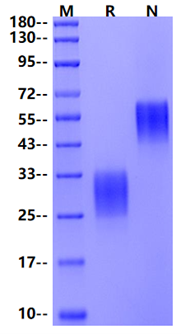Val19-Pro158, with C-terminal 8*His VHSQGALSAGNNSTEVEVVPFNEVWGRSYCRPMEKLVYILDEYPDEVSHIFSPSCVLLSRCSGCCGDEGLHCVPIKTANITMQILKIPPNRDPHFYVEMTFSQDVLCECRPILETTKAERRKTKGKRKRSRNSQTEEPHPGGGSHHHHHHHH
1. Review ProgRetin Eye Res.2019 Mar;69:116-136.Epub 2018 Oct 30.
Placental growth factor (PGF), also known as vascular endothelial growth factor-related proteins PLGF and PlGF2, is a member of the vascular endothelial growth factor (VEGF) family. PlGF is a three-dimensional structure composed of 149 amino acids. PlGF is a dimeric glycoprotein formed by a 69kD α chain and a 34kD β chain connected by disulfide bond, with a unique cystine junction. These junctions are characterized by eight spatially conserved cysteines that are involved in intramolecular and intermolecular disulfide bond formation. PlGF is a pleiotropic factor affects different cell types and regulates various biological responses.PGF is not only activated during angiogenesis and endothelial cell growth, stimulating their proliferation and migration, but also promoting cell tumor growth.

Measured in a cell proliferation assay using Balb/c 3T3 mouse fibroblast cells, the EC50 for this effect is less than 5ng/ml.

2μg (R: reducing condition, N: non-reducing condition).